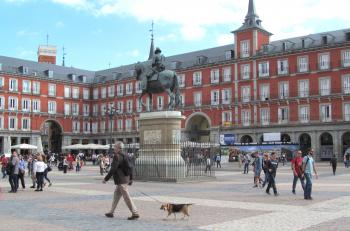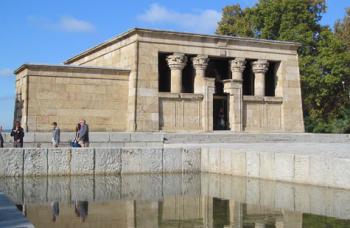An Egyptian temple in Madrid
This item appears on page 50 of the July 2018 issue.
In October 2017, my husband, Paul, and I rented an apartment in the iconic Plaza Mayor in the oldest section of Madrid. Using this apartment as our base, we enjoyed life Madrileño-style, spending weekdays viewingGoyas and El Grecos in the city’s many top-notch museums and weekends strolling in Retiro Park and hunting for treasures in the Rastro flea market.
At night, we nibbled tapas (appetizers) in the ubiquitous tapas bars of our neighborhood while deciding where to have dinner, followed by late nights at flamenco venues.
One afternoon late in our month-long trip, while strolling in the Parque de la Montaña not far from the Royal Palace, we “discovered” the Templo de Debod.
To find an Egyptian temple practically next door to the Royal Palace and close to the Plaza de España, with its huge monument to Miguel de Cervantes, was a bit surprising. How did this Egyptian temple get there?
The Temple of Debod was originally located in Upper Egypt close to the border with Lower Nubia in what is now Sudan. In the 1960s Egypt constructed the Aswan High Dam, creating the huge artificial Lake Nasser. Spain was one of several nations that helped rescue ancient temples from the lake waters.
As a thank you, in 1968 Egypt donated this temple to Spain. (The United States received a similar gift, the Temple of Dendur, now housed in New York City’s Metropolitan Museum of Art.) The Temple of Debod was disassembled, moved to Madrid and reassembled between 1970 and 1972.
History of Debod
Debod was built at the beginning of the 2nd century BC by Adikhalamani, a Nubian king who ruled Meroë.
His predecessor, Arqamani, had rebelled against the Egyptian pharaoh and extended his kingdom north into Egyptian territory. Adikhalamani built a small temple in this territory, dedicating it to Amun, greatest of the Egyptian gods. He decorated the temple’s interior walls with scenes depicting himself offering bread, water, wine and incense, among many other offerings, to a panoply of Egyptian gods, including Isis, Osiris and Horus.
When the pharaohs Ptolemy VI, Ptolemy VIII and Ptolemy XII regained control of their territory, they enlarged the temple, adding additional chapels attached to the main temple, although the sanctuary still remained relatively small in size.
When the Romans annexed Egypt in 30 BC after the defeat of Cleopatra VII and Mark Antony, they too left their mark, building a pronaos (partially open vestibule) with columns and decorating the inside façade.
Sometime after the 5th or 6th century AD, the Temple of Debod was abandoned and all but forgotten until European travelers began visiting Egypt in the 18th and 19th centuries. One early traveler was the Swiss explorer Johann Ludwig Burckhardt, who visited Debod in 1813. He wrote about Debod in his “Travels in Nubia,” published in 1819 two years after his death.
Architectural gem
Now, 2,200 years after it was first built, the Temple of Debod resides in a serene park in Madrid. It is an architectural gem in a majestic setting. The temple sits on a long oblong terrace set within a shallow pool that beautifully reflects its image.
Before entering the temple, itself, visitors should walk to the end of the terrace and then back through the two pylons, or gateways, that stand in front of the temple. A processional way once led through these pylons to the temple’s principal entrance.
Temple interior
The pronaos has carvings left by the Romans. Just beyond, a vestibule with walls filled with images of Adikhalamani and his many offerings to the many gods leads to a dark interior sanctuary, the naos, dedicated to Amun. This was the temple’s “holy of holies.”
On either side of the vestibule are oblong chapels added by the Ptolemaic pharaohs. In one of these chapels, there is a video projected on the stone walls that serves as an excellent visual introduction for visitors.
In the chapel on the other side of the Adikhalamani vestibule is a staircase leading up to a small museum with a plan of the temple’s layout, making it easy to visualize the way it once looked.
What is remarkable is that despite abandonment for over 12 centuries, the images of pharaohs and gods remain so vivid, probably because of the very abandonment that left them undisturbed for so long.
No matter how short your stay in Madrid is, don’t miss the opportunity of visiting this very un-Spanish monument. If you have the chance, return after sunset when the temple is artfully lit. Then it’s back to tapas bars and flamenco.
Closed during the month of December, the Templo de Debod (Calle Ferraz 1; phone 34 91 366 7415, www.madrid.es/templodebod [in Spanish only]) is open from 10 to 8 Tuesday to Sunday. (Best to check on these hours before visiting.) Admission is free, but be prepared to wait. (We stood in line for 30 minutes.) Only 30 people are permitted inside at any time, and they’re allowed no more than 30 minutes.
National Archaeological Museum
A perfect accompaniment to a visit to the Templo de Debod is a visit to Madrid’s National Archaeological Museum (Calle de Serrano 13; phone 34 91 577 7912, www.man.es/man/en/home), housing Spain’s largest collection of objects from ancient Egypt and Nubia.
One highlight is the mummy of the priest Nespamedu, whose face is covered with a gold mask. He was buried at Saqqara in Memphis, Egypt, in the Ptolemaic period at about the same time the Temple of Debod was being constructed.
Besides its Egyptian collection, the museum houses much more, including prehistoric, Greek, Roman and medieval artifacts. We returned three times. Closed Monday, the museum is open 9:30-8 Tuesday to Saturdayand 9:30-3 on Sunday.
If you go…
Our rental apartment, called Plaza Mayor IV, in Madrid’s Plaza Mayor was the perfect location for us. Almost everything we wanted to see in Madrid was within walking distance or a short cab ride away. Best of all was having more than a dozen cafés and restaurants within the Plaza Mayor, itself, no more than a few steps from our front door.
The 3-bedroom, 3-bath apartment had a spacious living/dining room and a large kitchen with dining space. The living room and master bedroom had floor-to-ceiling windows overlooking the plaza. Beyond perfect!
The apartment cost us €5,600 (about $6,590 at the time of our visit) for a 28-night stay. The rental agent was Spain Select (Hermosilla 21, Madrid, Spain 28001; phone 34 91 523 7451, www.spain-select.com).



